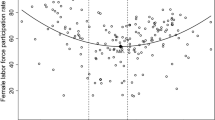Abstract
The fact that globally a gender gap exists along axes of economic, social and political outcomes is well documented. Studies have shown such gaps to be increasing or decreasing, changing by varying degrees, varying by magnitude depending on the period of study and region of analysis. The World Economic Forum’s Global Gender Gap Report shows tardy progress on closing the gender gaps along multiple axes. The report states that even while the global gender gap has become smaller since 2006, the extent of its closure is a measly four per cent; if this trend were allowed to perpetuate, it would take over a 100 years for the world’s women to be on par with men. India has tightened its gender gap by 2% in a year, which now stands at 68% across the four pillars of economy, education, health and political representation. The major improvement, however, has been witnessed in the arena of education, where the gaps in primary and secondary education have been completely eliminated. In the economic sphere, much work remains to be done. In so far as ensuring gender equality continues to be one of the objectives of Sustainable Development Goals, lack of it constitutes a challenge. Such gap is, however, either on account of inputs or characteristics that are different across members of different genders (the explained gap) or on account of differential premium on possession of comparable characteristics across genders (the unexplained gap). Decomposition of such gaps into their explained and unexplained fractions is important for the purpose of measuring the precise extent of gender discrimination. This paper fills a void in the existing literature by analysing such gaps in the wage market across select states of India. The paper uses the technique of Blinder–Oaxaca decomposition for the purpose of study, which has not been applied so far in studying inter-state characterization of gender wage gaps. Thereafter, the paper compares the results obtained for pooled wage market of India with results for urban and rural wage markets.
Similar content being viewed by others
Notes
But it is important recognize that it also captures all potential effects of differences in unobserved variables.
References
Banerjee, B., and J.B. Knight. 1983. Caste discrimination in the Indian labour market. Journal of Development Economics 17(1985): 277–307.
Bhaumik, S.K., and M. Chakrabarty. 2009. Is education the panacea for economic deprivation of Muslims: Evidence from wage earners in India, 1987–2005. Journal of Asian Economics 20(2): 137–149.
Blinder, A.S. 1973. Wage discrimination: Reduced form and structural estimates. The Journal of Human Resources 8: 436–455.
Borooah, V.K. 2005. Caste, inequality and poverty in India. Review of Development Economics 9(3): 399–414.
Cotton, J. 1988. On the decomposition of wage differentials. The Review of Economics and Statistics 70: 236–243.
Duraisamy, M., and P. Duraisamy. 1996. Women in the professional and technical labour market in India: Gender discrimination in education and employment and earnings. Indian Journal of Labour Economics 42(4): 599–612.
Haddad, S., K.S. Mohindra, K. Siekmans, G. Mak, and D. Narayana. 2012. Health divide between indigenous and non-indigenous populations in Kerala. BMC Public Health 12: 390.
ILO. 2016. Women at work: Trends 2016. International Labour Organisation.
ILO website www.ilo.org.
Jann, B. 2008. The Blinder Oaxaca decomposition for linear regression models. The Stata Journal 8(4): 453–479.
Khanna, S. 2012. Gender wage discrimination in India: Glass ceiling or sticky floor? CDE working paper no. 214. https://ssrn.com/abstract=2115074.
Kim, C.H. 2010. Decomposing the change in wage gap between white and black men over time 1990–2005. Sociological Methods and Research 38(4): 619–651.
Kingdon, G.G., and J. Unni. 1997. Education and women’s labour market outcomes in India. Education Economics 9(2): 173–195.
Madheswaran, S., and Khasnobis, B. G. 2007. Gender discrimination in the labour market: Evidence from the NSS. WIDER research project on gender wage gap and its impact on poverty: evidence from India.
Oaxaca, R. 1973. Male–female wage differentials in urban labor markets. International Economic Review 14: 693–709.
Poel, E.V., and Niko Speybroeck. 2009. Decomposing malnutrition inequalities between SC/STs and the remaining Indian population. Ethnicity and Health 14(3): 271–287.
Reilly, B., and Dutta, P. V. 1996. The gender pay gap and trade liberalisation: Evidence for India. Poverty research unit at sussex working paper no. 3.
WEF. 2016. The global gender gap report 2016. Accessed online.
Author information
Authors and Affiliations
Corresponding author
Rights and permissions
About this article
Cite this article
Chinara, M. Gender Discrimination in Wage Earnings: A Study of Indian Wage Market. Ind. J. Labour Econ. 61, 157–169 (2018). https://doi.org/10.1007/s41027-018-0132-5
Published:
Issue Date:
DOI: https://doi.org/10.1007/s41027-018-0132-5




